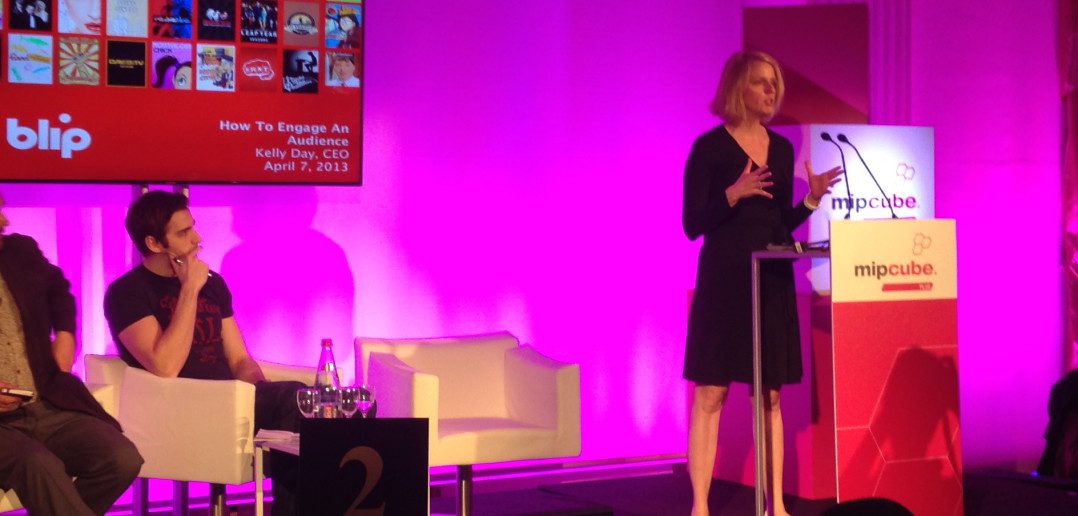Today’s MIPCube Plus event is divided neatly into three main sections: creating content, engaging audiences of users, and making money from this.
We covered the creating part this morning, but this afternoon saw attention turn to engaging with, and making money from, connected users. It kicked off with Kelly Day, CEO of US firm Blip (photo), and Ian Wharton, partner at British company Zolmo, talking about their experiences on the engagement side.
Day started by discussing the importance of engagement, versus scale. “It’s pretty easy to get scale. YouTube gets a billion unique visitors a month,” she said.
“And yet if scale were the only metric that mattered, why would buyers go anywhere else? There’s plenty of inventory available on YouTube… There are things that matter more than scale, and I believe that engagement is one of the most important metrics today, and in the future.”
Blip serves up original web-video series to its audience, with the average user (it has 25m uniques) visiting its service 2-3 times a month to watch 13-15 videos for between 60 and 80 minutes overall.
“We help audiences find shows that they’re going to fall in love with,” she said, noting that the passion of these audiences is what attracts advertisers, because they’re “hyper-engaged… The main reason advertisers love us is because of this great audience.”
She noted that the big challenge is content discovery, with “more content being created right now than there are audiences aggregated to consume this content”. So Blip starts by trying to pick the best original content from submissions – “we actually watch the content!” – with a strong emphasis on curation.
“Without naming names, when you come to our site, you don’t have to weed through Grumpy Cat and Justin Bieber videos to find a great show that you’re going to love,” she said (YouTube being the name not being named, obviously). Sharing and commenting is built into the Blip video player to fuel word-of-mouth buzz, and the shows are distributed across various devices and platforms.
Day showed an example: a show from the end of 2012 called The Gauntlet, which pitted 19 gamers against one another in a set of challenges.
Blip started building an audience for the show by choosing a production partner: Rooster Teeth. And new shows were released once a week – every Thursday night at 10pm. “And every Thursday night at 10, the audience showed up,” she said. “This may sound counter-intuitive, but… when you’re trying to aggregate audiences for an ad-supported model, you need to be able to cume audience.”
Pulling in an audience at a specific time also sparked social media buzz around the show. In 10 weeks, the show generated 5.3m views, a more than 40% episode completion rate, and a unique Twitter reach of 3.1m, with just under 950k Facebook impressions.
Over to Wharton from Zolmo, which describes itself as a mobile publisher. He started by talking about two key problems when trying to engage audiences: Digital value, and discovery.
“I’m not here to suggest that mobile’s on a course to obliterate all other forms of media,” he said. “What I’m here to say is mobile has its own very unique and very important place in the conversation, both in its own right, and as a companion to everything you’re doing.”
But yes, mobile has its challenges, starting with digital value. “The stats that we hear are things from Apple: 40 billion apps have been downloaded from the App Store, there are 800,000 apps available to download… these things sound very spectacular, but they are metrics based on vanity more than anything else.”
He quoted a review of one of Zolmo’s cookery apps, criticising it for costing the same as its physical book equivalent. He also noted that users, once they’ve paid for an app once, also expect lots of future updates for free.
This was an issue with Zolmo’s Jamie Oliver 20 Minute Meal apps, so for the follow-up, Zolmo switched strategy to a freemium model, selling recipe packs as in-app purchases.
“We’ve had 8m downloads of this app, but to begin with very little conversion. It took for the release of the iPad version for this to change,” he said. So iPad users are more willing to pay for content, and the in-app purchase model means new content can be delivered to them every month.
Now, Zolmo is moving its platform over to a subscription model, which he said initially caused “an enormous backlash”, but after a free trial for existing purchasers ran out, revenues tripled.
And that second challenge? Discovery, which Wharton says is a huge challenge for anyone trying to build premium app brands.
“App stores are an unrelenting torrent of absolute crap that you have to navigate to find what you want,” said Wharton. “Anyone can make an app and submit it, and millions of people can download it. And the quality is not premium, by and large.”
Zolmo is now working on a fitness app called Touchfit with mixed martial-artist Georges St-Pierre, which launches next week, including more than 500 video exercises. “We have the same production pipeline and post-production process that you have in TV,” said Wharton, who went on to say that familiar faces like St-Pierre and Oliver are important in cutting through the app store clutter.
“We partner with brands like Jamie and George St-Pierre to ride the Halo effect of their brand. It’s absolutely core to our strategy, and it reduces a lot of the risk,” he said.
In the Q&A section, Day was asked about how brands fit in to what Blip does. “Branded content has to start with the audience. We create shows that we know our audience is going to love, then we find the right brands to come in and work with it,” said Day, citing Geico’s sponsorship of The Gauntlet.
“It starts with creating a show that the audience is really going to connect with.”
The second session of the afternoon focused on the nitty-gritty of making money from all this engagement. Christopher Barry, managing director, international strategy and digital media at A+E Networks, and Chantal Rickards, head of programming/branded content at MEC Global, provided the opinions.
Barry spoke first, digging into a few case studies from A+E’s output across its own channels, programme sales and digital media. It has 58 channels reaching around 500m subscribers around the world. Its US channels include A+E, History and Lifetime, as well as non-US brand Crime & Investigation.
How does it make money? A mixture of advertising; audience development (moving digital audiences to its linear channels); brand building (distribution through pay-TV operators); content licensing; and Facebook and mobile games based on A+E’s core show franchises.
Barry provided some case studies, starting with Mankind, a 10-part mini-series on the history of mankind from prehistoric days onwards, with themes including food, tech and government.
A+E produced a mobile app that was released around the world – sometimes with the Mankind brand and sometimes without – while on social it produced an eight-week “editorial calendar” for country teams around the world, although they were able to customise it for local tastes.
Mankind was also distributed through various digital services through a mixture of deals. Among them: Viki, which does what Barry described as “crowdsourced translation” – it has an online community that translates videos then makes them available for other Viki users. Also Russian portal Ivi – “the Hulu of Russia… with a lot of American and Western content, with 16m unique visitors”.
Barry finished with games, including Facebook and mobile games based on Pawn Stars and Top Shot, as well as Storage Wars Slots on Facebook. “Most of the money we make on these games isn’t the advertisements, it’s the micropayments,” he said.
Chantal was up next to talk about media agency MEC’s strategy – it’s part of global group WPP – to talk about putting brand money into content (“but I’m not here to tell you how to do your job,” she stressed).
She noted that brands are increasingly keen to get into product placement, sponsorship, format adaptations and second-screen technology – with the latter being “the most fantastic space for brands to be able to play in, and it’s where we’re going to be spending a lot of the money in the future”
She added that brands “don’t really mind what the platform is, we don’t really mind what the content is, as long as it engages with the consumer” before giving some examples of product placement, including Heineken’s $45m spend in the last James Bond movie, and sponsorship – Visa’s Sprint Challenge with athlete Usain Bolt in Sky’s sports comedy show A League Of Their Own.
Chantal also discussed a format adaptation of reality show Big Brother in the UK involving Henkel and its Live XXL hair colouring products, before moving on to second-screen content, noting that some show types are good for this treatment, and others aren’t.
“If you’re not in the second-screen space, you’re nowhere, so you need to leap into it as fast as you can,” she said, suggesting brands can create “a deeper engagement with the audience”. She showed a demo of the Team Coco tablet app for Conan O’Brien’s US chat-show, which can be used while watching episodes live or on-demand. AT&T was the brand involved.
Chantal challenged producers and broadcasters to put 5% of their budgets (“at least”) into second-screen content, although she noted that this doesn’t mean brands shouldn’t also be putting money in.
But Chantal warned that second-screen shouldn’t be shoehorned into every television genre willy-nilly, showing a clip of Will.I.Am suggesting people might want to get phone calls and texts from characters while watching their favourite dramas.
“There has to be something about preserving content that you want to watch and not be disturbed. And at your peril do you mess around with something that is as fantastically engaging as really good drama. News and sport: wonderful places for second-screen. Drama? I’m not so sure.”
How much control should the broadcaster or brand have over the disruption associated to second-screen? Barry said that “as audience behaviour changes, we can’t find that… we have to lean into that… we have an opportunity, we need to lean into it and try to find new ways to reach our consumers”.
Chantal suggested that in linear television: “Nobody should have control but the channel. It is absolutely vital that that is preserved by the channel. A channel will always know their audience better than a brand will.”




